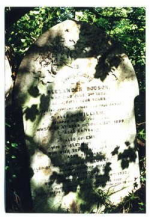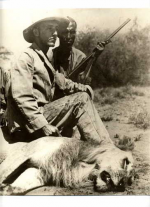Björn Bergenholtz
(former alias "Calalp")

Here´s a fourth list of some small additional information regarding the Etymology of ten various Bird Names that I´ve happened to stumble upon trying to understand various Swedish Bird Names … for your sake (as well as I can?) in English.
As far as I understand the following birds commemorates the following … :
No. 1 – "edwardsi" in …
● the strongly debated "subspecie" (?) Dactylortyx thoracicus chiapensis/"edwardsi" WARNER & HARRELL 1957: "We name this race for Ernest P. Edwards."
= US ornithologist, ecologist, field naturalist, teacher, lecturer and administrator Dr. Ernest P. Edwards (1919–2011), among friends known as "Buck".
No. 2 – randrianasoloi in …
● Cryptic warbler Cryptosylvicola randrianasoloi GOODMAN ET AL 1996
= the Malagasy multi-talented biologist, collector, guide and interpreter, as well as Park Director; Georges Randrianasolo (circa 1930–1989).
Also commemorated in; Randrianasolo’s Sportive Lemur Lepilemur randrianasoloi (ANDRIAHOLINIRINA et al. 2006; HOFFMANN et al. 2009). More on him in a forthcoming article by Olivier Langrand (Draft 2014): "Georges Randrianasolo (circa 1930 - 1989) – Malagasy botanist, entomologist, ornithologist and mammalogist". Be on the look-out!
No. 3 – nahani in …
● Nahan's Francolin (Francolinus/Ptilopachus/Acentrortyx) Pternistis nahani DUBOIS 1905 a k a "Nahan's Forest Francolin" or "Nahan's Partridge"
= the Belgian Commandant, army officer, explorer and collector Captain Paul François Joseph Nahan (1867–1930).
This Paul Nahan was born the 5th of November 1867, in the little village Ruette, in Virton southernmost Belgium. He enlisted, only sixteen years old, and served three times in Belgian Congo; 1891–1894, 1895–1899 and 1901–1904. It was during his third term that he discovered and collected the holotype, a female specimen, of this "his" Francolin. Mr. Nahan died on the 5th of May 1930, in his home-town Ruette.
No. 4 – wardi/wardii in …
● Ward's Trogon Harpactes wardi KINNEAR 1927
= the British explorer and collector Francis Kingdon Ward (1885–1958), among those who knew him known as "Frank".
● Pied Thrush (Geokichla) Zoothera wardii BLYTH 1843 a k a "Ward’s Thrush"
= the British Colonial administrator: Samuel Neville Ward (1813–1897), stationed in India between 1832 and 1863.
● Ward's Shrike-flycatcher Pseudobias wardi SHARPE 1870 a k a "Ward’s Flycatcher"
= the fairly unknown (at least among ornithologist's) British entomologist Christopher Ward (1836–1900), from the wool- and textile city Halifax, in west Yorkshire, England.
No. 5 – derbiana/derbianus in …
● Chestnut-tipped Toucanet Aulacorhynchus derbianus Gould 1835 (Synonymous with "Psittacula derbiana")
= the British Noble, zoologist, museologist, land-owner and politician ”Lord Derby” – whose "original" name was Edward Smith-Stanley (1775–1851), from 1834 titled 13th Earl of Derby, who had a large private collection of various Naturalia.
No. 6 – dodsoni in …
● Dodson's Bulbul Pycnonotus (barbatus) dodsoni SHARPE 1895 a k a "Dodson's Common Bulbul"
● the so called ”Cisticola dodsoni” SHARPE 1895 (synonymous with C. nana FISCHER & REICHENOW 1884 ... ?)
● and the questioned sub-species "Lanius algeriensis dodsoni" WHITAKER 1898 (of today's Lanius meriodinalis algeriensis LESSON 1839) according to NHM: "collected and presented by E. Dodson".
= the fairly unknown British adventurer, taxidermist and collector Edward Dodson (1873–1948), who on assignment from the British Museum explored the Fauna in large parts of Africa together Donaldson Smith. He later also visited Patagonia … etc. etc. The same Edward Dodson is also commemorated in for example, the African toad ”Bufo dodsoni” BOULENGER 1895: ”This species ... is named after Mr. E. Dodson, who accompanied Dr. Donaldson Smith as taxidermist.”
Not to be confused with (which often has been done) with his younger brother, whose commemorated in:
● the sub-species Burhinus capensis dodsoni OGILVIE-GRANT1899, described after a similar expedition to Southern Arabia "… undertaken by Mr. A Blayney Percival and the late Mr. W. Dodson".
= the even less known British explorer and collector W. Dodson (xxxx–1899), that died in Aden, Yemen, in 1899.
No. 7 – ducorpsi/ducorpsii in …
● Solomon Corella Cacatua ducorpsii PUCHERAN 1853 (sometimes written C. ducorpsi) a k a "Ducorps’s Cockatoo", "Ducorps' Cockatoo" or "Ducorps's cackatoo" as well as "Ducrops's Cockatoo" and "Durcorp's Cockatoo"!?
= the unknown French Naval officer, adjutant (Commis de marine de trosième classe), explorer and collector Louis Jacques Ducorps (1811–xxxx), who explored large part of the Pacific during admiral Dumont d’Urville's South Pole expedition 1837–1840.
No. 8 – dumontii in …
● Yellow-faced Myna Mino dumontii LESSON 1827
= the father-in-law to Lesson: the French Noble, lawyer, zoologist and amateur ornithologist; Charles Henri Frédéric Dumont de Sainte-Croix (1758–1830), whose Noble name sometimes is written without hyphen as; de Sainte Croix.
No. 9 – renauldi in …
● Coral-billed Ground-cuckoo Carpococcyx renauldi OUSTALET 1896 a k a "Renauld's Ground-cuckoo "
= the French missionary Père Jean Nicolas Renauld (1839–1898), who left France in 1867 for Hue, in French Indochina – and he never returned. His Christian names are sometimes written Jean-Nicolas (with hyphen).
No. 10 – nevermanni in …
● Grey-crowned Munia Lonchura nevermanni STRESEMANN 1934
= the (fairly unknown among ornithologists , but well-known in his respective fields!) German ethnologist, anthropologist, researcher of Oriental Languages, oceanographer, pre-historian and author of Travel Stories; Dr. Hans Paul Friedrich Wilhelm Nevermann (1902–1982), who mainly collected ethnological items and exotic Words (and at least two species of birds, the other one was Black munia L. stygia) on New Guinea, in 1933 – during a two year Expedition (1933-1934) to New Guinea and Melanesia (incl. Loyalty Islands, New Hebrides and New Caledonia). More on Hans Nevermann, see the following links to; Neue Deutsche Biographie 19 (1998) or German Wikipedia
Anyone of a different view?
And just for the fun of it ... (attached) a photo of the latter; Hans Nevermann.
Björn Bergenholtz, Stockholm, Sweden
PS. Don´t hesitate to prove me wrong. Any additional info regarding these etymologies are warmly welcomed! And; if I you feel like adding something, please clearly state which one you are commenting on … just to avoid confusion.
As far as I understand the following birds commemorates the following … :
No. 1 – "edwardsi" in …
● the strongly debated "subspecie" (?) Dactylortyx thoracicus chiapensis/"edwardsi" WARNER & HARRELL 1957: "We name this race for Ernest P. Edwards."
= US ornithologist, ecologist, field naturalist, teacher, lecturer and administrator Dr. Ernest P. Edwards (1919–2011), among friends known as "Buck".
No. 2 – randrianasoloi in …
● Cryptic warbler Cryptosylvicola randrianasoloi GOODMAN ET AL 1996
= the Malagasy multi-talented biologist, collector, guide and interpreter, as well as Park Director; Georges Randrianasolo (circa 1930–1989).
Also commemorated in; Randrianasolo’s Sportive Lemur Lepilemur randrianasoloi (ANDRIAHOLINIRINA et al. 2006; HOFFMANN et al. 2009). More on him in a forthcoming article by Olivier Langrand (Draft 2014): "Georges Randrianasolo (circa 1930 - 1989) – Malagasy botanist, entomologist, ornithologist and mammalogist". Be on the look-out!
No. 3 – nahani in …
● Nahan's Francolin (Francolinus/Ptilopachus/Acentrortyx) Pternistis nahani DUBOIS 1905 a k a "Nahan's Forest Francolin" or "Nahan's Partridge"
= the Belgian Commandant, army officer, explorer and collector Captain Paul François Joseph Nahan (1867–1930).
This Paul Nahan was born the 5th of November 1867, in the little village Ruette, in Virton southernmost Belgium. He enlisted, only sixteen years old, and served three times in Belgian Congo; 1891–1894, 1895–1899 and 1901–1904. It was during his third term that he discovered and collected the holotype, a female specimen, of this "his" Francolin. Mr. Nahan died on the 5th of May 1930, in his home-town Ruette.
No. 4 – wardi/wardii in …
● Ward's Trogon Harpactes wardi KINNEAR 1927
= the British explorer and collector Francis Kingdon Ward (1885–1958), among those who knew him known as "Frank".
● Pied Thrush (Geokichla) Zoothera wardii BLYTH 1843 a k a "Ward’s Thrush"
= the British Colonial administrator: Samuel Neville Ward (1813–1897), stationed in India between 1832 and 1863.
● Ward's Shrike-flycatcher Pseudobias wardi SHARPE 1870 a k a "Ward’s Flycatcher"
= the fairly unknown (at least among ornithologist's) British entomologist Christopher Ward (1836–1900), from the wool- and textile city Halifax, in west Yorkshire, England.
No. 5 – derbiana/derbianus in …
● Chestnut-tipped Toucanet Aulacorhynchus derbianus Gould 1835 (Synonymous with "Psittacula derbiana")
= the British Noble, zoologist, museologist, land-owner and politician ”Lord Derby” – whose "original" name was Edward Smith-Stanley (1775–1851), from 1834 titled 13th Earl of Derby, who had a large private collection of various Naturalia.
No. 6 – dodsoni in …
● Dodson's Bulbul Pycnonotus (barbatus) dodsoni SHARPE 1895 a k a "Dodson's Common Bulbul"
● the so called ”Cisticola dodsoni” SHARPE 1895 (synonymous with C. nana FISCHER & REICHENOW 1884 ... ?)
● and the questioned sub-species "Lanius algeriensis dodsoni" WHITAKER 1898 (of today's Lanius meriodinalis algeriensis LESSON 1839) according to NHM: "collected and presented by E. Dodson".
= the fairly unknown British adventurer, taxidermist and collector Edward Dodson (1873–1948), who on assignment from the British Museum explored the Fauna in large parts of Africa together Donaldson Smith. He later also visited Patagonia … etc. etc. The same Edward Dodson is also commemorated in for example, the African toad ”Bufo dodsoni” BOULENGER 1895: ”This species ... is named after Mr. E. Dodson, who accompanied Dr. Donaldson Smith as taxidermist.”
Not to be confused with (which often has been done) with his younger brother, whose commemorated in:
● the sub-species Burhinus capensis dodsoni OGILVIE-GRANT1899, described after a similar expedition to Southern Arabia "… undertaken by Mr. A Blayney Percival and the late Mr. W. Dodson".
= the even less known British explorer and collector W. Dodson (xxxx–1899), that died in Aden, Yemen, in 1899.
No. 7 – ducorpsi/ducorpsii in …
● Solomon Corella Cacatua ducorpsii PUCHERAN 1853 (sometimes written C. ducorpsi) a k a "Ducorps’s Cockatoo", "Ducorps' Cockatoo" or "Ducorps's cackatoo" as well as "Ducrops's Cockatoo" and "Durcorp's Cockatoo"!?
= the unknown French Naval officer, adjutant (Commis de marine de trosième classe), explorer and collector Louis Jacques Ducorps (1811–xxxx), who explored large part of the Pacific during admiral Dumont d’Urville's South Pole expedition 1837–1840.
No. 8 – dumontii in …
● Yellow-faced Myna Mino dumontii LESSON 1827
= the father-in-law to Lesson: the French Noble, lawyer, zoologist and amateur ornithologist; Charles Henri Frédéric Dumont de Sainte-Croix (1758–1830), whose Noble name sometimes is written without hyphen as; de Sainte Croix.
No. 9 – renauldi in …
● Coral-billed Ground-cuckoo Carpococcyx renauldi OUSTALET 1896 a k a "Renauld's Ground-cuckoo "
= the French missionary Père Jean Nicolas Renauld (1839–1898), who left France in 1867 for Hue, in French Indochina – and he never returned. His Christian names are sometimes written Jean-Nicolas (with hyphen).
No. 10 – nevermanni in …
● Grey-crowned Munia Lonchura nevermanni STRESEMANN 1934
= the (fairly unknown among ornithologists , but well-known in his respective fields!) German ethnologist, anthropologist, researcher of Oriental Languages, oceanographer, pre-historian and author of Travel Stories; Dr. Hans Paul Friedrich Wilhelm Nevermann (1902–1982), who mainly collected ethnological items and exotic Words (and at least two species of birds, the other one was Black munia L. stygia) on New Guinea, in 1933 – during a two year Expedition (1933-1934) to New Guinea and Melanesia (incl. Loyalty Islands, New Hebrides and New Caledonia). More on Hans Nevermann, see the following links to; Neue Deutsche Biographie 19 (1998) or German Wikipedia
Anyone of a different view?
And just for the fun of it ... (attached) a photo of the latter; Hans Nevermann.
Björn Bergenholtz, Stockholm, Sweden
PS. Don´t hesitate to prove me wrong. Any additional info regarding these etymologies are warmly welcomed! And; if I you feel like adding something, please clearly state which one you are commenting on … just to avoid confusion.
Attachments
Last edited:







